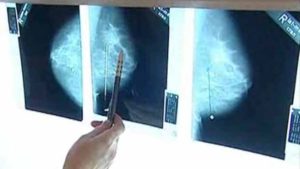 The following is an excellent commentary by Dr. John Mandrola regarding an important British Medical Journal article that I posted about earlier (see Rethinking Cancer Screening). He has a highly regarded web-site and also frequently posts on Medscape. His view is that cancer screening "may be one of Medicine’s largest reversals. A reversal happens when something (testing or treatment) doctors did, and patients accepted, turned out to be non-beneficial." (www.drjohnm.org)
The following is an excellent commentary by Dr. John Mandrola regarding an important British Medical Journal article that I posted about earlier (see Rethinking Cancer Screening). He has a highly regarded web-site and also frequently posts on Medscape. His view is that cancer screening "may be one of Medicine’s largest reversals. A reversal happens when something (testing or treatment) doctors did, and patients accepted, turned out to be non-beneficial." (www.drjohnm.org)
I can't overstate how big a reversal this is in medicine - it's huge, a paradigm change in the making. The reason for this is that studies show that overall death rates are basically the same in screened vs non-screened for mammography, colon, prostate, and lung cancer screening. This means our view of how cancer grows and spreads may have to be reexamined and changed. One possibility suggested by Dr. H. Gilbert Welch is that aggressive cancer is already "a systemic disease by the time it's detectable" (Oct. 28, 2015 post). From Medscape:
In Cancer Screening, Why Not Tell the Truth?
The problem: cancer screening has not worked. Recent reviews of the evidence show that current-day screening techniques do not save lives. Worse, in many cases, these good-intentioned searches bring harm to previously healthy people.
I realize this sounds shocking. It did to me, too. Millions of women and men have had their breasts squished, veins poked, lungs irradiated, and bowels invaded in the name of "health" maintenance. I've been scolded for forgoing PSA tests and colonoscopy — "you should know better, John."....Anecdotes, however compelling, are not evidence. When you pull up a chair, open your computer, take a breath, suspend past beliefs, and look for the evidence that screening saves lives, it simply isn't there.
One reason that this many people (doctors and patients alike) have been misled about screening has been our collective attachment to the belief that if screening lowers disease-specific death rates, that would translate to lower overall mortality. That is: breast, lung, and colon cancer are bad diseases, so it makes sense that lowering death from those three types of cancer would extend life. It is not so.
In a comprehensive review of the literature[1] published in the BMJ, Drs Vinay Prasad (Oregon Health Sciences University, Portland) and David Newman (School of Medicine at Mount Sinai, New York), along with journalist Jeanne Lenzer, find that disease-specific mortality is a lousy surrogate for overall mortality. They report that when a screening technique does lower disease-specific death rates, which is both uncommon and of modest degree, there are no differences in overall mortality.
The authors cite three reasons why cancer screening might not reduce overall mortality:
- Screening trials were underpowered to detect differences. I'm no statistician, but doesn't the fact that a trial requires millions of subjects to show a difference, mean there is little, if any, difference?
- "Downstream effects of screening may negate any disease-specific gains." My translation: harm. Dr Peter Gøtzsche (Nordic Cochrane Center, Copenhagen) wrote in a commentary[2] that "screening always causes harm. Sometimes it also leads to benefits, and sometimes these benefits outweigh the harms." To understand harm resulting from screening, one need only to consider that a prostate biopsy entails sticking a needle through the rectum, or that some drugs used to treat breast cancer damage the heart.
- Screening might not reduce overall mortality because of "off-target deaths." An illustration of this point is provided by a cohort study[3]that found a possible increased risk of suicide and cardiovascular death in men in the year after being diagnosed with prostate cancer. People die — of all sorts of causes, not just cancer.
Let's also be clear that this one paper is not an outlier. A group of Stanford researchers performed a systematic review and meta-analyses[4] of randomized trials of screening tests for 19 diseases (39 tests) where mortality is a common outcome. They found reductions in disease-specific mortality were uncommon and reductions in overall mortality were rare or nonexistent.
Drs Archie Bleyer and H Gilbert Welch (St Charles Health System, Central Oregon, Portland) reviewed Surveillance, Epidemiology, and End Results (SEER) data from 1976 through 2008 and concluded that "screening mammography has only marginally reduced the rate at which women present with advanced cancer and that overdiagnosis may account for nearly a third of all new breast cancer cases."[5] Likewise, a Cochrane Database Systematic review[6] of eight trials and 600,000 women did not find an effect of screening on either breast cancer mortality or all-cause mortality. This evidence caused the Swiss medical board to abolish screening mammography.[7]
These are the data. It's now clear to me that mass cancer screening does not save lives. But I'm still trying to understand how this practice became entrenched as public-health gospel. It has to be more than fear. Dr Gerd Gigerenzer (Max Planck Institute, Berlin, Germany)...He pointed to language and the ability of words to persuade. Instead of saying "early detection," advocates might use the term "prevention." This, Dr Gigerenzer says, wrongly suggests screening reduces the odds of getting cancer. Doesn't looking for cancer increase the odds of getting the diagnosis of cancer?
Gigerenzer noted two other ways language is used to emphasize screening benefits over harms: -The reporting of benefits in relative, not absolute terms. - The equating of increases in 5-year survival rates with decreases in mortality. I would add to this list of word misuse, the practice of referring to women sent to mammography screening as patients. They are not patients; they are well people. Dr Gigerenzer agreed with the commonsense notion that overall mortality should be reported along with cancer-specific mortality. His editorial included a fact box on breast cancer early detection using mammography provided by the Harding Center for Risk Literacy. I challenge you to tell me why such text boxes should not be shown to people before they undergo screening,
The first action healthcare experts should take is to spread the word that there is nothing about the mass screening of healthy people for cancer that equates to health maintenance. Embrace clear language. Saying or implying that screening saves lives when there are no data to support it and lots to refute it undermines trust in the medical profession.
The second action healthcare experts should take is to stop wasting money on screening. If the evidence shows no difference in overall mortality, why pay for it? I'm not naive to the fact that use of clear language will decrease the number of billable procedures. I am not saying this will be easy. One first move that would be less painful would be to get rid of quality measures or incentives that promote screening.
I want to be clear; I'm not saying all cancer screening is worthless. People at higher baseline risk for cancer, such as those with a family history of cancer or environmental exposures, might derive more benefit than harm from screening. Prasad, Lenzer, and Newman say this group of patients would be a good place to spend future research dollars. That sounds reasonable. I also acknowledge that some people, even when presented with the evidence, will want to proceed with screening. We can argue about who should pay for non–evidence-based medical procedures.
 Some studies with humans suggest that cancer growth is slowed with exercise, better cancer prognosis with regular exercise, and lowered cancer recurrence (e.g., exercise after prostate cancer diagnosis), but a recent study looked at the issue more in depth.
Some studies with humans suggest that cancer growth is slowed with exercise, better cancer prognosis with regular exercise, and lowered cancer recurrence (e.g., exercise after prostate cancer diagnosis), but a recent study looked at the issue more in depth.
 The following is an excellent commentary by Dr. John Mandrola regarding an important British Medical Journal article that I posted about earlier (see
The following is an excellent commentary by Dr. John Mandrola regarding an important British Medical Journal article that I posted about earlier (see  This study was done in mice, but...it may apply to humans. The researchers found that sugar intake in mice comparable with levels in Western diets (in humans) led to increased breast tumor growth and metastasis.They specifically found that
This study was done in mice, but...it may apply to humans. The researchers found that sugar intake in mice comparable with levels in Western diets (in humans) led to increased breast tumor growth and metastasis.They specifically found that  Reading this recent study, I was struck by how the results are evidence for eating sulforaphane containing foods, such as kale, cauliflower, brussels sprouts, broccoli, and cabbage for health and preventing cancer (due to anti-tumor activity). It is debatable whether it is support for taking supplements (here a sulforaphane supplement called BSE), even though the researchers were testing the supplement. Seven days of taking a supplement without "serious adverse events" (but they did have minor ones such as "mild abdominal discomfort") is too short a length of time for any support for a product. The real test would be seeing what health effects, both positive and negative, are after a year or two of taking the supplement.
Reading this recent study, I was struck by how the results are evidence for eating sulforaphane containing foods, such as kale, cauliflower, brussels sprouts, broccoli, and cabbage for health and preventing cancer (due to anti-tumor activity). It is debatable whether it is support for taking supplements (here a sulforaphane supplement called BSE), even though the researchers were testing the supplement. Seven days of taking a supplement without "serious adverse events" (but they did have minor ones such as "mild abdominal discomfort") is too short a length of time for any support for a product. The real test would be seeing what health effects, both positive and negative, are after a year or two of taking the supplement. Research for a doctoral thesis found that thousands of chemicals (from manufacturing the textiles and clothes) remain on finished clothes, and many of these remain after washing. Bottom line: wash new clothes before wearing! From Science Daily:
Research for a doctoral thesis found that thousands of chemicals (from manufacturing the textiles and clothes) remain on finished clothes, and many of these remain after washing. Bottom line: wash new clothes before wearing! From Science Daily: